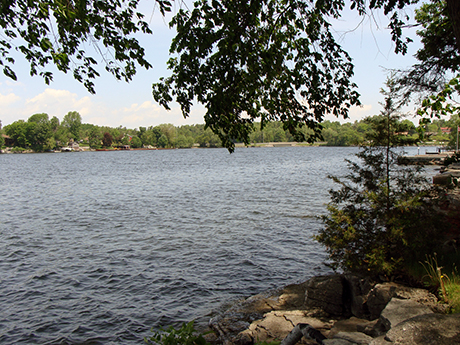
The Lake Ontario Maritime Cultural
Landscape Project
12 August 2008
By Ben Ford
The Lake Ontario of today is not the same body of water that existed as recently as 6000 years ago. The shape and size of the lake has shifted several times since humans first occupied its margins (at least 12,000 years ago); at one time spreading approximately 20 miles farther inland and then shrinking to as much as 12 miles lakeward from the current shoreline. These fluctuations were caused by changes in the rate and direction of water flow as glaciers blocked and freed rivers and the geography of the region changed over millennia. By circa 5000 years ago, the lake level had stabilized and, with minor variations, the shoreline closely resembled what we see today. However, there are also earlier shoreline sites preserved in the surrounding landscape, far from the current lake (www.cemml.colostate.edu/paleo/index.htm), and likely other pre-Contact Native American sites submerged on the lake bottom.
Lake Iroquois, an earlier, larger version of Lake Ontario (Library and Archives Canada NMC17450). Click on map to zoom in for a closer look.
We hoped to find one of these submerged sites in this season’s third and final survey area, Parrotts Bay. Parrotts Bay was a promising location for several reasons: there was an early French estate in the vicinity and the bay was situated between two late-18th century British settlements, but the major draw was reports of submerged hearths (fire pits) in the area. We hoped that our diver surveys could identify and substantiate the claims of a submerged pre-Contact site.

Parrotts Bay, note the rocky shore in the foreground.
Unfortunately, we were unsuccessful. Much of the area where the submerged hearths were reported consists of narrow terraces separated by rocky slopes. In general this area does not appear to be easily habitable. The presence of large stones on the slopes suggests that the original surface has either eroded away or been buried under the rocks, either way it is not immediately accessible and it is unlikely that hearths are visible on the lake bottom here.
Despite our disappointment with the Parrotts Bay area, Lake Ontario is still likely to contain submerged pre-Contact sites. The water level of Lake Ontario rose quickly and would have inundated many sites with little erosion. The same cold, dark waters that preserve historic shipwrecks nearly intact would do the same for sites left by Native Americans along the submerged shores of the lake. These sites have the potential to contain materials such as bone, wood, and hide that are seldom found in terrestrial sites. Some of these sites may be deeply buried in the sediment fan of the Niagara River but others may be just below the lake bottom along a former river channel leading to a now-drowned predecessor of Lake Ontario.
Please feel free to contact Ben at ben.ford@iup.edu with any comments, questions, or suggestions during the weeks to come.
Return to Project Journal home page.

